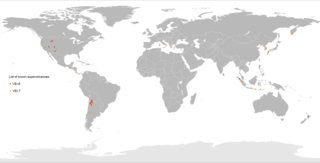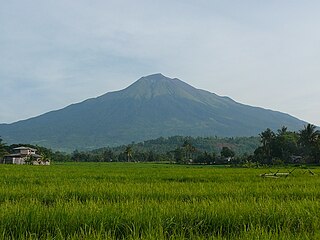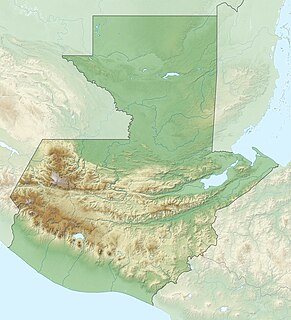
A supervolcano is a large volcano that has had an eruption of magnitude 8, which is the largest value on the Volcanic Explosivity Index (VEI). This means the volume of deposits for that eruption is greater than 1,000 cubic kilometers.

A stratovolcano, also known as a composite volcano, is a conical volcano built up by many layers (strata) of hardened lava, tephra, pumice and ash. Unlike shield volcanoes, stratovolcanoes are characterized by a steep profile with a summit crater and periodic intervals of explosive eruptions and effusive eruptions, although some have collapsed summit craters called calderas. The lava flowing from stratovolcanoes typically cools and hardens before spreading far, due to high viscosity. The magma forming this lava is often felsic, having high-to-intermediate levels of silica, with lesser amounts of less-viscous mafic magma. Extensive felsic lava flows are uncommon, but have travelled as far as 15 km (9.3 mi).

The Nevado del Ruiz, also known as La Mesa de Herveo is located on the border of the departments of Caldas and Tolima in Colombia, about 129 kilometers (80 mi) west of the capital city Bogotá. It is a stratovolcano composed of many layers of lava alternating with hardened volcanic ash and other pyroclastic rocks. Nevado del Ruiz has been active for about two million years, since the Early Pleistocene or Late Pliocene, with three major eruptive periods. The current volcanic cone formed during the present eruptive period, which began 150 thousand years ago.

The Yellowstone Caldera is a volcanic caldera and supervolcano in Yellowstone National Park in the Western United States, sometimes referred to as the Yellowstone Supervolcano. The caldera and most of the park are located in the northwest corner of Wyoming. The major features of the caldera measure about 34 by 45 miles.

A crater lake is a lake that forms in a volcanic crater or caldera, such as a maar; less commonly and with lower association to the term a lake may form in an impact crater caused by a meteorite, or in the crater left by an artificial explosion caused by humans. Sometimes lakes which form inside calderas are called caldera lakes, but often this distinction is not made. Crater lakes covering active (fumarolic) volcanic vents are sometimes known as volcanic lakes, and the water within them is often acidic, saturated with volcanic gases, and cloudy with a strong greenish color. For example, the crater lake of Kawah Ijen in Indonesia has a pH of under 0.5. Lakes located in dormant or extinct volcanoes tend to have fresh water, and the water clarity in such lakes can be exceptional due to the lack of inflowing streams and sediment.

Mount Pinatubo is an active stratovolcano in the Zambales Mountains, located on the tripoint boundary of the Philippine provinces of Zambales, Tarlac and Pampanga, all in Central Luzon on the northern island of Luzon. Its eruptive history was unknown to most before the pre-eruption volcanic activities of 1991, just before June. Pinatubo was heavily eroded, inconspicuous and obscured from view. It was covered with dense forests which supported a population of several thousand indigenous Aetas.

Kelud is an active stratovolcano located in East Java, Indonesia. Like many Indonesian volcanoes and others on the Pacific Ring of Fire, Kelud is known for large explosive eruptions throughout its history. More than 30 eruptions have occurred since 1000 AD. In 2007, an effusive explosion filled the crater with a lava dome. It last erupted on February 13, 2014, destroying the lava dome and ejecting boulders, stones and ashes up to West Java about 500 kilometers from Mount Kelud. The crater filled with water during the rainy season.

Viedma is a subglacial volcano located below the ice of the Southern Patagonian Ice Field, an area disputed between Argentina and Chile. The 1988 eruption deposited ash and pumice on the ice field and produced a mudflow that reached Viedma Lake. The exact position of the edifice is unclear, both owing to the ice cover and because the candidate position, the "Viedma Nunatak", does not clearly appear to be of volcanic nature. Numerous ash layers in the Viedma lake indicate numerous past eruptions.

Cerro Azul, sometimes referred to as Quizapu, is an active stratovolcano in the Maule Region of central Chile, immediately south of Descabezado Grande. Part of the South Volcanic Zone of the Andes, its summit is 3,788 meters (12,428 ft) above sea level, and is capped by a summit crater that is 500 meters (1,600 ft) wide and opens to the north. Beneath the summit, the volcano features numerous scoria cones and flank vents.

Supervolcano is a 2005 British-Canadian disaster television film that originally aired on 13 March 2005 on BBC One, and released by the BBC on 10 April 2005 on the Discovery Channel. It is centered on the speculated and potential eruption of the volcanic caldera of Yellowstone National Park. Its tagline is "Scientists know it as the deadliest volcano on Earth. You know it...as Yellowstone."

The Minoan eruption of Thera, also referred to as the Thera eruption, Santorini eruption, or the Late Bronze Age eruption, was a major catastrophic volcanic eruption with a Volcanic Explosivity Index (VEI) of 6 or 7 and a dense-rock equivalent (DRE) of 60 km3 (14 cu mi), Dated to the mid-second millennium BCE, the eruption was one of the largest volcanic events on Earth in recorded history. It devastated the island of Thera, including the Minoan settlement at Akrotiri, as well as communities and agricultural areas on nearby islands and the coast of Crete with related earthquakes and tsunamis.

Kanlaon, also spelled as Kanla-on or sometimes Canlaon, is an active stratovolcano on the island of Negros, Philippines. It is the highest point in Negros, as well as the whole Visayas, with an elevation of 2,465 m (8,087 ft) above sea level.

The Bruneau-Jarbidge caldera is located in present-day southwest Idaho. The volcano erupted during the Miocene, between ten and twelve million years ago, spreading a thick blanket of ash in the Bruneau-Jarbidge event and forming a caldera. Animals were suffocated and burned in pyroclastic flows within a hundred miles of the event, and died of slow suffocation and starvation much farther away, notably at Ashfall Fossil Beds, located 1,000 miles downwind in northeastern Nebraska, where up to two meters of ash were deposited. At the time, the caldera was above the Yellowstone hotspot.

Less commonly publicized than the effects on aviation—and with less potential for catastrophe—maritime Impacts of volcanic eruptions are also dangerous. When a volcano erupts, large amounts of noxious gases, steam, rock, and ash are released into the atmosphere; fine ash can be transported thousands of miles from the volcano, while high concentrations of coarse particles fall out of the air near the volcano. The high concentrations of hazardous toxic gases are localized in the immediate vicinity of the volcano.

The 2010 eruptions of Eyjafjallajökull were volcanic events at Eyjafjallajökull in Iceland which, although relatively small for volcanic eruptions, caused enormous disruption to air travel across western and northern Europe over an initial period of six days in April 2010. Additional localised disruption continued into May 2010. The eruption was declared officially over in October 2010, when snow on the glacier did not melt. From 14–20 April, ash from the volcanic eruption covered large areas of Northern Europe. About 20 countries closed their airspace to commercial jet traffic and it affected approximately 10 million travellers.
The International Volcanic Health Hazard Network (IVHHN) is an organization that provides research and information on the health hazards and impacts of volcanic eruptions. IVHHN work covers a range of research areas including volcanology, toxicology, public health and exposure science, with the goal of determining the health impacts of volcanic emissions and how to protect exposed communities.

Ticsani is a volcano in Peru. It consists of two volcanoes that form a complex: "old Ticsani", which is a compound volcano that underwent a large collapse in the past and shed 15–30 cubic kilometres (3.6–7.2 cu mi) of mass down the Rio Tambo valley; the other is a complex of three lava domes which were emplaced during the Holocene. The last eruption occurred after the 1600 eruption of neighbouring Huaynaputina.

The 2018 Volcán de Fuego eruption was a series of volcanic explosions and pyroclastic flows from the Volcán de Fuego in Guatemala on Sunday 3 June 2018. The eruption included lahars, pyroclastic flows, and clouds of volcanic ash, which left almost no evacuation time and caused the death of nearly two hundred people. It was the deadliest eruption in Guatemala since 1929.



















